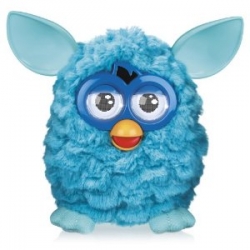
Future Fragments: Love and Robots From Teddy Ruxpin to Furby
Written by: Anastasia Salter, Pop-Culture Editor
 Robot & Frank may not have made it to a widespread release, but it is perhaps the ultimate buddy comedy of the future. The premise — a senior citizen and his robotic companion restart the man’s former career as a cat burglar — would be unremarkable perhaps without the robot. The movie even uses the real robot ASIMO as the foundation for Frank’s robotic ally. With so little left to science fiction, and artificial intelligence and robotics extending every day, the movie’s world may be just around the corner. And our own “real” robotic companions are on their way, including the newly relaunched Furby.
Robot & Frank may not have made it to a widespread release, but it is perhaps the ultimate buddy comedy of the future. The premise — a senior citizen and his robotic companion restart the man’s former career as a cat burglar — would be unremarkable perhaps without the robot. The movie even uses the real robot ASIMO as the foundation for Frank’s robotic ally. With so little left to science fiction, and artificial intelligence and robotics extending every day, the movie’s world may be just around the corner. And our own “real” robotic companions are on their way, including the newly relaunched Furby.
Children in particular have already grown up with automated friends to extend the “imaginary friend” concept to technically-enhanced levels. As a child of the 80s, I remember the day my Teddy Ruxpin died. He was one of the first automated companions with a powerful combination of simple animatronics and gentle stories on casette tapes–oh yes, actual *tapes.* Teddy Ruxpin’s limited function was the clear prototype for other science fiction robots, most notably Teddy in A.I., a reminder that the robotics we might reject as humanoid could easily fill the role of protector and companion:
I’m not the only one whose memories of Teddy Ruxpin followed me into adulthood, though not all of those memories are as sweet as Teddy’s nature suggested. Teddy Ruxpin’s nature might have been scripted, and his ability to lip sync with readings was baed on appropriate input connected to each casette, but his potential for expressiveness could reach greater levels. The “T,E.D.” art installation’s creepy rewired Teddy Ruxpins channeling the emotional voice of the Internet offer a particularly wild glimpse of what happens when Teddy Ruxpin meets the real digital age.
Outside of art, Teddy Ruxpin has already been resurrected with MP3 cartridges in place of old cassette tapes and now Furby is making a reappearance. Furby is an odd construct, rather like Gizmo of Gremlins, as Furby asks the child to be caretaker and mentor. Even the original Furby worked on a premise of language acquisition, suggesting that the child’s attention gradually allowed the Furby to become more “real.” No Furby has ever had an off switch, rather like the Tamagotchi pets that once filled schools with their buzzing reminders for food and attention. After all, does life have an off switch? (Just ask the frustrated parents forced to remove Furby’s batteries for peace and quiet at night–a vicious solution that effectively “killed” the Furby.) My own Furby essentially disappeared after we learned that leaving Furby in a locked dark cabinet at night was not enough to convince Furby to sleep.
In Alone Together, Sherry Turkle explored some of the unexpected consequences of children’s attachment with Furby, including desperate attempts at resurrection of “deceased” toys. I never tried to resurrect Teddy Ruxpin, but I do now own his identical repaired twin. And now I’m supposedly a grown-up, which means I can keep Teddy Ruxpin in repairs–and I know when to keep Furby without his batteries. But there’s no way yet for a toy to grow up with us, stuck as they are in a simplistic state, waiting perhaps until old age makes us once again more susceptible to the appeal of virtual companionship. Or perhaps the state of learning artificial intelligence will eventually allow us to recreate the foul-mouthed and knowledgable evolution imagined in Ted:
We’re probably still some pixie dust away from lifelong companions like Ted or even Frank’s robot. By now, I expected our automated companions to have grown significantly. New Furby’s integration with iOS apps is a start to allowing for more complex interactions, and it will definitely be interesting to see what imprint this new Furby leaves on children of the right age to bond with its digitally-enhanced features. It’s certainly a far cry from changing the casette tape to hear a new story, but it’s also a long ways from the emotional connections so easy to project on the original teddy bears. There are a few cool signs of the next generation offering more complexity. Kickstarter-funded project Ubooly, a strange creature with a iPhone for a face inserted in the middle of a plushy body, promises to answer questions like “What is the meaning of life?” with humor suited to Siri, the iPhone’s more faceless personal assistant.
